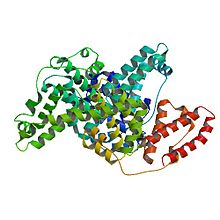User:Lauryn1204/sandbox
| Familial dysalbuminemic hyperthyroxinemia | |
|---|---|
| Specialty | Endocrinology |
Familial dysalbuminemic hyperthyroxinemia (FDH) rare genetic condition that is a common cause of euthyroid hyperthyroxinemia and is associated with mutations in the human serum albumin gene.[1][2] It is an autosomal dominant condition that is often mistaken for resistance to thyroid hormone (RTH) syndromes or hyperthyroidism. [3][4] FDH is characterized by high levels of thyroxine (T4) and normal levels of thyroid stimulating hormone (TSH).[3] Due to the mutations in the albumin gene, an abnormal albumin protein binds thyroid hormones with a high affinity than normal.[4] This explains why those with familial dysalbuminemic hyperthyroxinemia have increased T4 levels and normal TSH levels.[4]

Signs and Symptoms
[edit]Familial dysalbuminemic hyperthyroxinemia is usually asymptomatic.[4] The clinical features are not specific and vary from patient to patient.[3] In some cases, symptoms such as those seen in hyperthyroidism have been recorded like: palpitations, weight loss, tremors, and anxiety.[4][5]
Cause
[edit]The mutations in the albumin gene cause an increase in T4 levels because the albumin now binds more readily to T4. Despite the increased levels of T4, TSH levels remain normal.[6] Because of genetic sequencing, the following albumin gene variants have been recorded in patients with FSH: p.Arg218His (R218H), p.Arg218Pro (R218P), p.Arg218Ser (R218S), p.Arg222Ile (R222I), and p.Leu66Pro (L66P). [5]

Pathophysiology
[edit]*****Dr. W, because of what I explained in the cause section, I'm not sure what to put here because the condition is asymptomatic and treatment is not required. Could you please give me feedback on this section.*****
Diagnosis
[edit]Due to patients generally being asymptomatic, diagnosis of familial dysalbuminemic hyperthyroxinemia is usually made incidentally when abnormal thyroxine levels are detected during routine testing such as a thyroid function test.[3] To be certain, gene sequencing could also be performed to confirm the diagnosis of FDH. This would also allow for the patient and providers to know which albumin gene variant that particular patient has. Protein electrophoresis can also be used to confirm a diagnosis of FDH. [7] This test measures specific proteins in the blood and in the case of testing for FDH, albumin would be the protein that is isolated.
Treatment/Management
[edit]Due to patients being asymptomatic and euthyroid, treatment is not required for those with familial dysalbuminemic hyperthyroxinemia.[2]
Prognosis
[edit]The prognosis of those with FDH is favorable due to the patients being asymptomatic and not requiring treatment.[2]
Epidemiology
[edit]In the Caucasian population, the prevalence of familial dysalbuminemic hyperthyroxinemia is estimated at 1 in 10,000 individuals. The prevalence is higher in those of Hispanic origin compared to those in populations in Venezuela, France, and Denmark.[3]
References
[edit]- ^ Petitpas I, Petersen CE, Ha CE, et al. (May 2003). "Structural basis of albumin–thyroxine interactions and familial dysalbuminemic hyperthyroxinemia". Proceedings of the National Academy of Sciences, USA. 100 (11): 6440–5. Bibcode:2003PNAS..100.6440P. doi:10.1073/pnas.1137188100. PMC 164465. PMID 12743361.
- ^ a b c Fukaishi, Takahiro; Sekiguchi, Yoshihiro; Hara, Yoshihito (2017). "Familial Dysalbuminemic Hyperthyroxinemia that was Inappropriately Treated with Thiamazole Due to Pseudo-thyrotoxic Symptoms". Internal Medicine. 56 (16): 2175–2180. doi:10.2169/internalmedicine.8619-16. ISSN 0918-2918. PMC 5596280. PMID 28781323.
{{cite journal}}: CS1 maint: PMC format (link) - ^ a b c d e Dieu, Xavier; Bouzamondo, Nathalie; Briet, Claire; Illouz, Frédéric; Moal, Valérie; Boux de Casson, Florence; Bouhours-Nouet, Natacha; Reynier, Pascal; Coutant, Régis; Rodien, Patrice; Mirebeau-Prunier, Delphine (2020-07-03). "Familial Dysalbuminemic Hyperthyroxinemia: An Underdiagnosed Entity". Journal of Clinical Medicine. 9 (7): 2105. doi:10.3390/jcm9072105. ISSN 2077-0383. PMC 7408830. PMID 32635414.
{{cite journal}}: CS1 maint: PMC format (link) CS1 maint: unflagged free DOI (link) - ^ a b c d e Ruiz, Miguel; Rajatanavin, Rajata; Young, Ruth A.; Taylor, Charles; Brown, Rosalind; Braverman, Lewis E.; Ingbar, Sidney H. (1982-03-18). "Familial Dysalbuminemic Hyperthyroxinemia: A Syndrome That Can Be Confused with Thyrotoxicosis". New England Journal of Medicine. 306 (11): 635–639. doi:10.1056/NEJM198203183061103. ISSN 0028-4793.
- ^ a b Zhao, Linlin; Zhou, Yingying; Huang, Fengjiao; He, Xiaoyang; Mei, Guili; Wang, Shoujun; Zhao, Yanyan (2023-02-14). "Clinical characteristics of familial dysalbuminemic hyperthyroxinemia in Chinese patients and comparison of free thyroxine in three immunoassay methods". Frontiers in Endocrinology. 14. doi:10.3389/fendo.2023.1102777. ISSN 1664-2392. PMC 9971560. PMID 36864842.
{{cite journal}}: CS1 maint: PMC format (link) CS1 maint: unflagged free DOI (link) - ^ Khoo, Serena; Lyons, Greta; Solomon, Andrew; Oddy, Susan; Halsall, David; Chatterjee, Krishna; Moran, Carla (2020-02-26). "Familial dysalbuminemic hyperthyroxinemia confounding management of coexistent autoimmune thyroid disease". Endocrinology, Diabetes & Metabolism Case Reports. 2020 (1). doi:10.1530/EDM-19-0161. ISSN 2052-0573. PMC 7077549. PMID 32101523.
{{cite journal}}: CS1 maint: PMC format (link) - ^ Weiss, Roy E.; Refetoff, Samuel (2016-01-01), Jameson, J. Larry; De Groot, Leslie J; de Kretser, David M.; Giudice, Linda C. (eds.), "Chapter 78 - Thyroid Function Testing", Endocrinology: Adult and Pediatric (Seventh Edition), Philadelphia: W.B. Saunders, pp. 1350–1398.e11, doi:10.1016/b978-0-323-18907-1.00078-0, ISBN 978-0-323-18907-1, retrieved 2024-11-05
